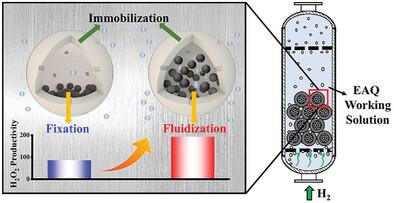Improving the Hydrogenation Performance of Nano-Catalysts by Constructing a Cavity-Constrained Fluidized System
IF 13
2区 材料科学
Q1 CHEMISTRY, MULTIDISCIPLINARY
引用次数: 0
Abstract
Nano-catalysts demonstrate exceptional performance in heterogeneous reactions, yet their potential is often underutilized due to a lack of attention to engineering design. In this study, an innovative encapsulated structure is presented for nano-catalysts and a corresponding catalytic system. Using an oil-in-water droplet strategy, millimeter-sized hollow spherical alumina (Al2O3-HS) is fabricated with an average diameter of ≈3 mm and a hollow void size of ≈1 mm. This approach enables the one-step encapsulation of nanoscale Pd/Al2O3 within the Al2O3-HS. The resulting assembly is immobilized within a tubular reactor for the hydrogenation of 2-ethylanthraquinone, with hydrogen introduced from the bottom of the reactor. Remarkably, the encapsulated catalyst achieved twice the H2O2 productivity of conventional supported catalysts. This enhancement is attributed to the cavity-constrained fluidization behavior of Pd/Al2O3 within the hollow alumina spheres. The design introduces a novel catalytic system that combines shell-immobilization with the fluidization of encapsulated nano-catalysts. As the gas velocity exceeds the minimum fluidization velocity, the Pd/Al2O3 particles remain highly accessible while allowing efficient gas and product flow. This hybrid approach integrates the advantages of fixed-bed and fluidized-bed systems, offering a promising solution to the technical challenges limiting the industrial application of nano-catalysts.

求助全文
约1分钟内获得全文
求助全文
来源期刊

Small
工程技术-材料科学:综合
CiteScore
17.70
自引率
3.80%
发文量
1830
审稿时长
2.1 months
期刊介绍:
Small serves as an exceptional platform for both experimental and theoretical studies in fundamental and applied interdisciplinary research at the nano- and microscale. The journal offers a compelling mix of peer-reviewed Research Articles, Reviews, Perspectives, and Comments.
With a remarkable 2022 Journal Impact Factor of 13.3 (Journal Citation Reports from Clarivate Analytics, 2023), Small remains among the top multidisciplinary journals, covering a wide range of topics at the interface of materials science, chemistry, physics, engineering, medicine, and biology.
Small's readership includes biochemists, biologists, biomedical scientists, chemists, engineers, information technologists, materials scientists, physicists, and theoreticians alike.
 求助内容:
求助内容: 应助结果提醒方式:
应助结果提醒方式:


